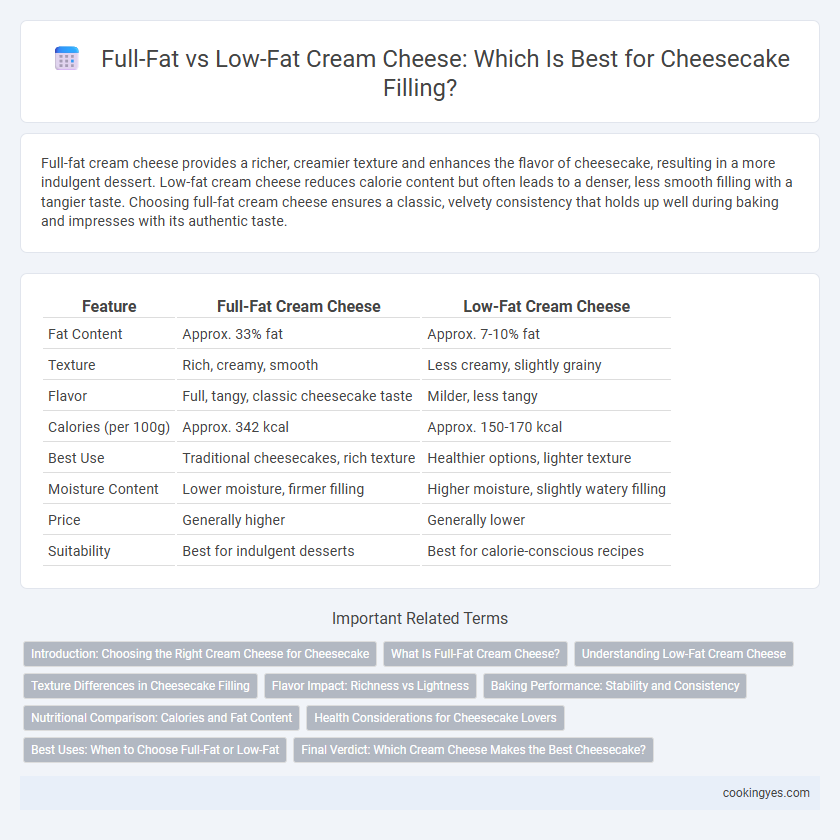Full-fat cream cheese provides a richer, creamier texture and enhances the flavor of cheesecake, resulting in a more indulgent dessert. Low-fat cream cheese reduces calorie content but often leads to a denser, less smooth filling with a tangier taste. Choosing full-fat cream cheese ensures a classic, velvety consistency that holds up well during baking and impresses with its authentic taste.
Table of Comparison
| Feature | Full-Fat Cream Cheese | Low-Fat Cream Cheese |
|---|---|---|
| Fat Content | Approx. 33% fat | Approx. 7-10% fat |
| Texture | Rich, creamy, smooth | Less creamy, slightly grainy |
| Flavor | Full, tangy, classic cheesecake taste | Milder, less tangy |
| Calories (per 100g) | Approx. 342 kcal | Approx. 150-170 kcal |
| Best Use | Traditional cheesecakes, rich texture | Healthier options, lighter texture |
| Moisture Content | Lower moisture, firmer filling | Higher moisture, slightly watery filling |
| Price | Generally higher | Generally lower |
| Suitability | Best for indulgent desserts | Best for calorie-conscious recipes |
Introduction: Choosing the Right Cream Cheese for Cheesecake
Full-fat cream cheese delivers a rich, creamy texture essential for classic cheesecake, while low-fat cream cheese offers a lighter option with reduced calories but a slightly tangier taste and less smooth consistency. The fat content in full-fat cream cheese helps achieve a dense and velvety filling that holds structure during baking. Opting for low-fat versions can affect the cheesecake's firmness and mouthfeel, making it crucial to balance health goals with desired dessert quality.
What Is Full-Fat Cream Cheese?
Full-fat cream cheese contains at least 33% fat, providing a rich, creamy texture essential for traditional cheesecake filling. This higher fat content enhances the cheesecake's smoothness and depth of flavor, resulting in a dense and velvety consistency. In contrast, low-fat cream cheese has reduced fat, which can lead to a lighter texture but often sacrifices the classic richness associated with traditional cheesecakes.
Understanding Low-Fat Cream Cheese
Low-fat cream cheese contains less fat and fewer calories than full-fat cream cheese, making it a popular choice for those seeking a lighter cheesecake option. It has a higher moisture content and slightly tangier flavor, which can affect the texture and richness of the cheesecake filling. Adjustments in recipe ratios and baking times may be necessary to achieve the desired consistency when using low-fat cream cheese.
Texture Differences in Cheesecake Filling
Full-fat cream cheese produces a rich, dense, and smooth cheesecake filling with a velvety texture due to its higher fat content. Low-fat cream cheese results in a lighter, slightly grainier texture that can sometimes feel less creamy and more watery. Choosing full-fat over low-fat cream cheese impacts the mouthfeel and structural integrity of the cheesecake, making it firmer and more indulgent.
Flavor Impact: Richness vs Lightness
Full-fat cream cheese provides a rich, creamy texture and deep flavor that enhances the indulgence of cheesecake filling, delivering a luxurious mouthfeel. Low-fat cream cheese offers a lighter, tangier taste with less richness, resulting in a less dense and more refreshing dessert experience. Choosing between them impacts the overall flavor profile and texture intensity of the final cheesecake.
Baking Performance: Stability and Consistency
Full-fat cream cheese provides superior baking performance in cheesecake filling due to its higher fat content, which ensures better stability and a creamier, denser texture. Low-fat cream cheese often results in a less stable batter that may curdle or separate during baking, compromising the cheesecake's consistency and smoothness. The fat in full-fat cream cheese acts as a binder, enhancing the overall structure and preventing cracks in the finished cheesecake.
Nutritional Comparison: Calories and Fat Content
Full-fat cream cheese contains approximately 99 calories and 9.8 grams of fat per ounce, delivering a rich and creamy texture essential for classic cheesecake recipes. Low-fat cream cheese reduces calorie content to about 70 calories and 4 grams of fat per ounce, offering a lighter alternative while slightly altering the creaminess and mouthfeel of the filling. Choosing between full-fat and low-fat options affects both the nutritional profile and the cheesecake's final texture, influencing the balance between indulgence and calorie control.
Health Considerations for Cheesecake Lovers
Full-fat cream cheese offers a richer texture and creamier taste for cheesecake fillings but contains higher saturated fat and calorie levels, which may impact heart health if consumed excessively. Low-fat cream cheese provides a reduced-calorie alternative with less saturated fat, appealing to those managing cholesterol levels or seeking weight control while sacrificing some creaminess and flavor intensity. Cheesecake lovers focused on health should balance indulgence with portion control and consider the nutritional trade-offs between full-fat and low-fat cream cheese options.
Best Uses: When to Choose Full-Fat or Low-Fat
Full-fat cream cheese provides a rich, creamy texture ideal for classic, indulgent cheesecakes that require a smooth, dense filling. Low-fat cream cheese works well in lighter, lower-calorie cheesecake recipes where a slightly tangier taste and less creamy consistency are acceptable. Choosing full-fat cream cheese enhances flavor and mouthfeel, while low-fat versions suit healthier dessert options without sacrificing structure.
Final Verdict: Which Cream Cheese Makes the Best Cheesecake?
Full-fat cream cheese delivers a richer, creamier texture and authentic flavor essential for classic cheesecake filling, ensuring a smooth and dense consistency. Low-fat cream cheese often results in a lighter, less creamy texture with added moisture that can affect the cheesecake's structure and mouthfeel. For the best traditional cheesecake, full-fat cream cheese remains the preferred choice for optimal taste and texture.
Full-fat cream cheese vs low-fat cream cheese for cheesecake filling Infographic

 cookingyes.com
cookingyes.com